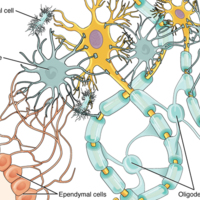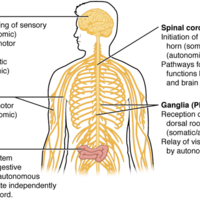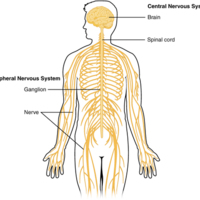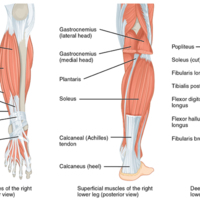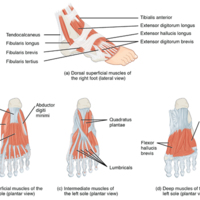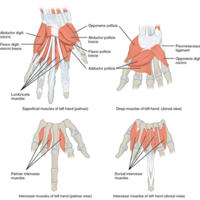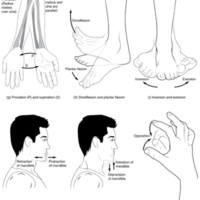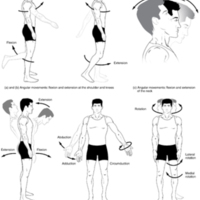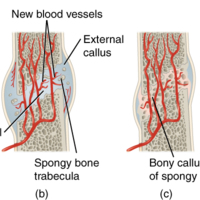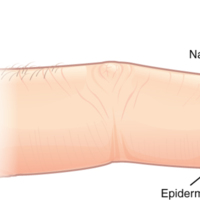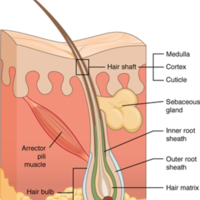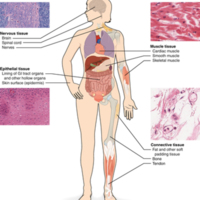Browse Items (15 total)
- Tags: Body
Sort by:
Glial Cells of the CNS
The CNS has astrocytes, oligodendrocytes, microglia, and ependymal cells that support the neurons of the CNS in several ways.
Somatic, Autonomic, and Enteric Structures of the Nervous System
Somatic structures include the spinal nerves, both motor and sensory fibers, as well as the sensory ganglia (posterior root ganglia and cranial nerve ganglia). Autonomic structures are found in the nerves also, but include the sympathetic and…
Central and Peripheral Nervous System
The structures of the PNS are referred to as ganglia and nerves, which can be seen as distinct structures. The equivalent structures in the CNS are not obvious from this overall perspective and are best examined in prepared tissue under the…
Muscles of the Lower Leg
The muscles of the anterior compartment of the lower leg are generally responsible for dorsiflexion, and the muscles of the posterior compartment of the lower leg are generally responsible for plantar flexion. The lateral and medial muscles in both…
Intrinsic Muscles of the Foot
The muscles along the dorsal side of the foot (a) generally extend the toes while the muscles of the plantar side of the foot (b, c, d) generally flex the toes. The plantar muscles exist in three layers, providing the foot the strength to…
Intrinsic Muscles of the Hand
The intrinsic muscles of the hand both originate and insert within the hand. These muscles provide the fine motor control of the fingers by flexing, extending, abducting, and adducting the more distal finger and thumb segments.
Muscles of the Diaphragm
The diaphragm separates the thoracic and abdominal cavities.
Movements of the Body, Part 2
(g) Supination of the forearm turns the hand to the palm forward position in which the radius and ulna are parallel, while forearm pronation turns the hand to the palm backward position in which the radius crosses over the ulna to form an "X." (h)…
Tags: Anatomy & Physiology, Body, Movement
Movements of the Body, Part 1
Synovial joints give the body many ways in which to move. (a)–(b) Flexion and extension motions are in the sagittal (anterior–posterior) plane of motion. These movements take place at the shoulder, hip, elbow, knee, wrist, metacarpophalangeal,…
Tags: Anatomy & Physiology, Body, Movements
Stages in Fracture Repair
The healing of a bone fracture follows a series of progressive steps: (a) A fracture hematoma forms. (b) Internal and external calli form. (c) Cartilage of the calli is replaced by trabecular bone. (d) Remodeling occurs.
Tags: Anatomy & Physiology, Body, Fracture
Types of Fractures
Compare healthy bone with different types of fractures: (a) closed fracture, (b) open fracture, (c) transverse fracture, (d) spiral fracture, (e) comminuted fracture, (f) impacted fracture, (g) greenstick fracture, and (h) oblique fracture.
Tags: Anatomy & Physiology, Body, Fractures
Nails
The nail is an accessory structure of the integumentary system.
Tags: Anatomy & Physiology, Body, Nails
Hair
Hair follicles originate in the epidermis and have many different parts.
Tags: Anatomy & Physiology, Body, Hair
Four Types of Tissue: Body
The four types of tissues are exemplified in nervous tissue, stratified squamous epithelial tissue, cardiac muscle tissue, and connective tissue in small intestine. Clockwise from nervous tissue
Tags: Anatomy & Physiology, Body, Types of Tissue


